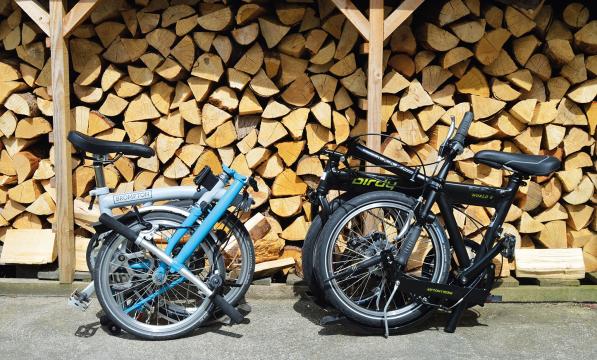Bike test: Folding e-bikes

The Gocycle G4 and Tern Vektron Q9 are premium-quality electric folders with distinct differences. Neither fits the ultra-portable category populated by 16-inch wheelers like the Brompton Electric and the Flit. Their 20-inch wheels are the basis for exhilarating, speedy riding (in the case of the Gocycle) or workhorse cargo-carrying capability (the Tern).
The fact that they fold is useful nevertheless. They can be stored in a studio flat or easily transported by train. And, of course, compared to an unpowered folder, they’ll take you further and with less effort over more demanding terrain.
Both are quite expensive if you consider the purchase price alone but, as with any e-bike, running costs are minimal. Long term, they’re much, much cheaper than a car. The Gocycle is an excellent commuter, while the Tern could be a car replacement like an e-cargo bike.
Frame and fold
The Gocycle uses three main frame materials: a weight-saving carbon fibre mid-frame; a hydroformed aluminium front frame; and a magnesium Cleandrive transmission casing. It also has a carbon fibre single-sided ‘fork’. The Tern is more conventional in using hydroformed aluminium throughout: 7005 alloy for the distinctive frame and 6061 for the fork.
The Gocycle’s design prioritises low weight and a sporty ride, whereas the Tern emphasises strength and carrying capacity – its extended rear end accommodates a stretched out rear rack, and it has sturdy-looking frame joints and hinges. As a result the Tern weighs 27% more than the Gocycle, at 23kg versus 18.1kg on my scales.
The Gocycle’s height-adjustable seatpost is made to fit riders from 5ft 1in to 6ft 6in, although there’s a compact option that drops that range to 4ft 10in to 5ft 9in. Tern says that the Q9 resizes in seconds to fit riders from 4ft 10in to 6ft 5in. This is thanks to a telescopic seatpost and the fore and aft adjustment of the bike’s Andros stem.


Both bikes fold in half rather than tucking the rear wheel underneath like a Brompton or Birdy. I found the Gocycle quicker and easier to fold, and the resulting package is lighter and more compact, making it easier to lift on and off trains.
The Tern’s fold is straightforward and easy enough to do but I would have liked a stronger magnet or even a strap system like the Gocycle’s to keep the folded halves together.
Both bikes can be wheeled along when folded by extending the seatpost and/or handlebar. It’s just as well; you wouldn’t want to run along a station platform carrying these bikes. With practice, you should be able to folder either bike in under 30 seconds. Folded sizes are broadly similar. The Gocycle rests nicely on its kickstand, while the folded Tern can also be stood up on the rear rack, which I actually found the most stable position.
Components
The Gocycle G4 had a design update a couple of years ago which, as well as new frame materials and a carbon fork, saw the introduction of an all-new G4drive front hub motor. This is quieter and has more torque than its predecessor, despite its discreet appearance.
Like almost every element of the Gocycle, the hub motor is the manufacturer’s own design. It’s paired with a 300Wh battery, which is neatly hidden in the frame. When the bike is folded, you can slide the battery out to recharge it away from the bike. The Gocycle’s battery can be used to charge other devices as there’s a 1A USB-C outlet on the handlebar.
The Tern has an efficient, reliable and superbly smooth Bosch mid-drive motor. As an Active Line Plus unit, this isn’t the most powerful in the range but then the Vektron isn’t an e-MTB or full-blown cargo bike, and the lower torque rating compared to top-end mid-drives doesn’t seem to dent its hill-climbing ability, which is excellent.
The Vektron Q9 (there’s also an S10) gets a frame-mounted and removable 400Wh Bosch Power Pack battery as standard. It’s compatible with 300Wh and 500Wh Power Packs as well. Both the Gocycle and Tern come with fast (4A) chargers with estimated charging times of three and four hours respectively.


The handlebar displays are very different. The Tern has an easy-to-use Purion display. Gocycle owners can choose between the minimalist Fuel Gauge display (a line of red LEDs in the handlebar that show battery capacity and the selected assistance mode) or the Gocycle app; you’ll need to attach your phone to the handlebar via the rubber loops provided to use that. The Gocycle app is the only way to change power levels on the fly.
The G4 retains Gocycle’s longstanding ‘Cleandrive’, a 3-speed hub-gear drivetrain that’s fully enclosed in a structural chaincase. In contrast, the Tern has a wider-range 9-speed derailleur drivetrain. Both bikes have extremely effective hydraulic disc brakes, and both come with full mudguards and good-quality, hardwired LED lights.
Accessories
The Gocycle has an optional 24-litre bespoke front bag, rated for up to 8kg and attaching via a proprietary fitting system. It costs £149.99, plus £24.99 for its rain cover. There is also an optional rear rack with a single-sided support that’s rated for 10kg. This can’t be removed quickly and so sticks out even when the bike is folded.
To carry the Gocycle itself, there are two options: a slip-over lightweight cover (£29.99) for the train; and a substantial travel case (£229), which looks great for protection but isn’t really bike portable – although it does have luggage wheels for use on foot.
The Tern has a plethora of optional extras. Check out the accessories section on Tern’s website, using ‘Vektron’ as a filter. The two accessories I’d find most useful are the Stow Bag, a foldable cover and carry bag combined (£140, 1.37kg), and the Bucketload Panniers (each of which costs £85 and carries up to 24 litres/9kg). Unlike most folders, you can also fit a child seat to the Tern Vektron’s rack.
The ride
Both bikes are stable and manoeuvrable enough for busy streets, and they’re comfortable to ride. The Gocycle benefits from a small amount of rear suspension, and both bikes have shock-absorbing, large-volume tyres.
The Gocycle feels the livelier of the two, making it easier to manoeuvre in tight spaces. Each bike has quite an upright riding position, although the Tern’s adjustable stem gives some scope to alter this.


So far, so similar, so let’s concentrate on the two areas where they differ most: motor performance and power controls. The Gocycle’s front hub motor springs into life very shortly after you start to turn the pedals, and if you use the small red boost button by your left thumb, you get instantaneous maximum power as long as the pedals are turning. The motor may be small but it accelerates quickly, making the Gocycle a really enjoyable e-bike to ride.
On hills up to about 15%, the Gocycle is one of the best e-bikes I’ve ridden. It also managed a 20%-plus climb, where lower gearing would have helped. Gocycle’s own slick tyres are plush yet fast rolling and grippy, and the bike overall feels stiff and efficient. It’s superb for busy urban traffic, where you feel (and generally are) safer if you can get ahead of other vehicles when setting off from junctions.
The Tern Vektron isn’t as lively as the Gocycle on the flat or up moderate hills but it’s no slouch. The Bosch Active Line mid-drive and wider gear range come into their own as you add more and more weight (which is easy to do, given the load-carrying options) and as the hills get steeper.
I took both bikes up my steepest local track, which I usually use only for testing electric mountain bikes. The Gocycle just managed to crest the hill, after a lot of heaving on the bars. The Tern ascended sedately and easily in bottom gear. Had I loaded the Tern with another 20 or 30 kilos, I doubt it would have made much difference.
The e-bike controls are very different. The Tern’s Bosch Purion display includes power-level buttons, an on/off switch, and a walk-assist button. It’s intuitive and faff free. To change between power levels on the Gocycle, you need the Gocycle app – with your phone attached to the handlebar if you want to change levels on the go.
I’d be tempted to leave the Gocycle in its lively ‘City+’ ride mode and rely on the Fuel Gauge LEDs to see the charge remaining. The Fuel Gauge is wonderfully simple, although not as accurate as Bosch’s battery capacity numbers.


Both bikes returned range figures in the ballparks I expected for the foothills of the Pennines: 20-25 miles for the Gocycle; 30-35 miles for the Tern. To get these figures, I only used the Gocycle’s boost button when it was really needed. Excessive use would eat into the range considerably.
I used Gocycle’s neat front bag for carrying personal belongings but only scratched the surface of the Tern’s huge load-carrying potential by fitting rear panniers to the capacious rear rack. Tern e-bikes with children on rear seats are not an uncommon sight in the UK’s biggest cities. You could also tow pretty much any cargo or child trailer with the Tern, whereas the Gocycle is limited to trailers with a seatpost hitch.
Verdict
There’s a clear choice here. If you want to speed through town traffic and to fold your bike quickly and easily for carriage by train, the Gocycle wins. If you’re going to be carrying significant loads or taking on really steep hills with any appreciable load at all, it has to be the Tern. The fact that the Tern folds is a bonus – and you could commute by train with it – but it’s not as easy to do so compared with the Gocycle.
Other options
Cytronex Brompton Kit +£1,145

Add a bespoke Cytronex conversion kit to a (£2,355) Brompton P-Line and you get a benchmark fold plus a high-quality hub motor system in a package weighing just over 13kg.
Vello Bike+ Automatic £2,990

Fairly quick and compact belt-drive folder with the latest generation ‘all-in-one-hub’ Zehus motor system and 2-speed Schlumpf bottom bracket gear. Folds to 79×57×29cm, weighs 16.4kg.
First published in Cycle magazine, August/September 2023 issue. All information correct at time of publishing.
Cycle magazine
Every two months Cycling UK members receive Cycle magazine, filled with interesting and informative articles, news and reviews for all cyclists.
Members can read the magazine in full online; non-members can read selected highlights.







